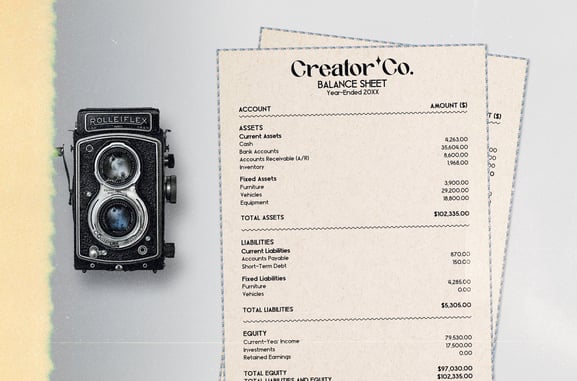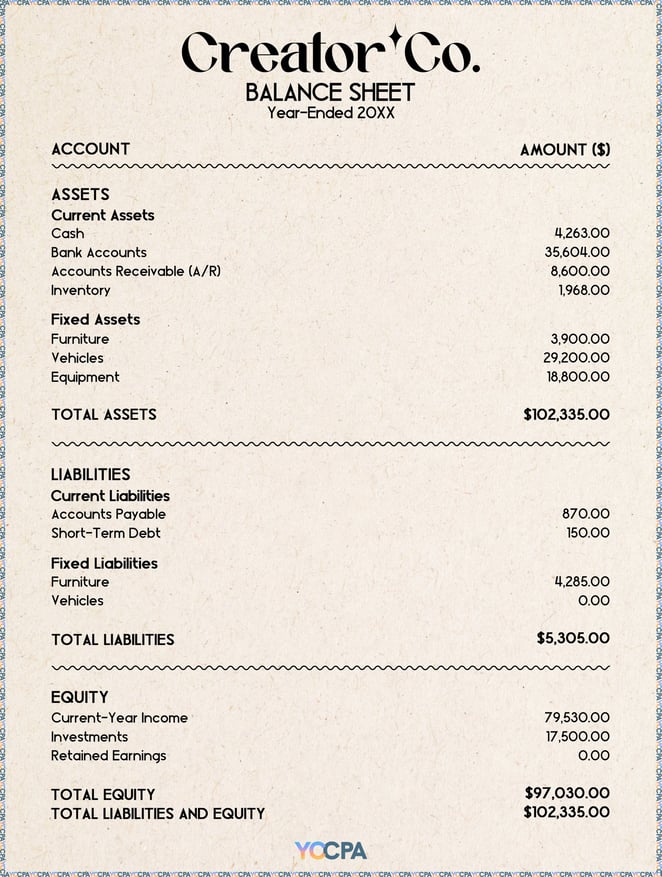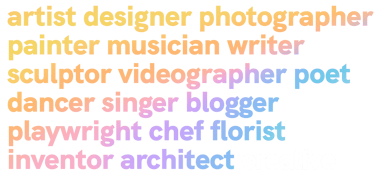
Latest Article: Bitcoin Isn't as Decentralized as You Think. Here's Why.
What is a Balance Sheet? A Guide for Creators
Own your balance sheet: a balance is a financial statement that shows a company's assets, liabilities, and equity at a specific point in time. Learn how to create a balance sheet, see an example of one, and more.
ACCOUNTINGJUMPSTARTINVESTINGBUSINESS
David Kindness, CPA
4/13/2024



What is a Balance Sheet? A Guide for Creators
Updated on April 12, 2024
Written by David Kindness, CPA
Why you can trust Your Creative CPA
Our content is written, edited, or both by industry experts who are creative entrepreneurs just like you. Learn more.
Ever wonder what your creative business is actually "worth"? Accounting terminology can be confusing, but a financial report called a Balance Sheet can be incredibly helpful for understanding and optimizing the value of your creative business.
This article will explain what a balance sheet is, how to read one, and how they can help you understand the financial health of your creative business.
Fast Facts About Balance Sheets
A balance sheet is a financial snapshot of your business's assets, liabilities, and equity at a specific point in time.
It shows what you own (assets), what you owe (liabilities), and what's left over (equity).
Once you understand your balance sheet, you'll be better equipped to make investment and debt payment decisions.
A Balance Sheet is one of three major financial statements - the other two are the Income Statement and the Statement of Cash Flows.
What is a Balance Sheet?
Imagine a balance sheet like a financial snapshot of your creative business at a specific date, listing your assets, liabilities, and equity.
First, it lists everything your business owns (your assets). This includes things like your computer, camera, music equipment, and other assets.
Next, it lists everything your business owes (your debts or liabilities). This includes things like auto loans, credit card debt, unpaid bills, future rent or mortgage payments, and other liabilities.
Finally, it shows what's left over after you subtract your liabilities from your assets, which is called equity (kind of like your business net worth).
Many businesses create balance sheets monthly, quarterly, or annually, so they can keep track of their business's assets, liabilities, and equity over time.
What Are Balance Sheets Used For?
A balance sheet is an incredibly helpful tool for business owners. All businesses both, large and small, utilize balance sheets to make better financial decisions. You might be asking "Why are balance sheets important?" Let's answer that by looking at a few of the major reasons below...
Understand business value: Balance sheets give you a clear picture of what your business owns and owes at a specific time.
Make financial decisions: Knowing your assets, liabilities, and equity helps you understand your financial health and decide on things like investments, loans, or future business goals.
Track your progress over time: Preparing balance sheets regularly (usually quarterly or annually) allows you to compare your balance sheets over time to see how your assets, liabilities, and equity are changing.
Attract investors: If you're looking for investors, a balance sheet shows them how financially stable your business is.
What Information Do You Include On A Balance Sheet?
A balance sheet is like a two-sided scale: assets on one side and liabilities and equity (combined) on the other. Here's a breakdown:
Assets: Everything your business owns that has value. These can be things you can physically touch (like equipment) or intangible things (like copyrights).
Liabilities: Everything your business owes money on, like loans, unpaid bills, or taxes. Think of it as your business debts.
Equity: This is the money left over after you subtract your liabilities from your assets. It represents the owner's investment in the business.
Remember: For a balance sheet to be balanced (like a scale), the total value of your assets must always equal your total liabilities plus equity. If they don't balance, then your balance sheet must be missing something - an account could be missing, a number could be wrong, or a formula could be incorrect.
Below is an example of what a balance sheet looks like and what information is included on it:


Now that we understand the basics of balance sheets, what they look like, and what they're used for, let's go into a little more detail on the information included on balance sheets below...
What Are Assets? Plus Common Assets Included on Balance Sheets
Assets are anything of value that you or your business own. They could include cash, investments, equipment, cars, houses, and more. Something as large as an office building and as small as a paper clip are considered assets and can be included on your balance sheet.
Balance sheets include a few different categories of assets to help businesses (and business owners) differentiate between asset types. These asset categories include current assets, long-term (AKA fixed) assets, and intangible assets. Let's explore the differences below:
Current (Short-Term) Assets: These are assets that can be easily converted into cash within a year. Examples include cash in your bank account (it's already cash!), investments in the stock market or in bonds, your inventory of products, or money owed to you by customers (accounts receivable).
Fixed (Long-Term) Assets: These are long-term assets that you use in your business, like property (land), buildings or houses, computers, furniture, and other equipment like cameras, lenses, and other design tools. Long-term assets generally last at least one year, and many last much longer than that.
Intangible Assets: These are assets that don't have a physical form but still have value, such as copyrights, trademarks, goodwill, or patents.
What Are Liabilities? Plus Common Liabilities Included on Balance Sheets
"Liabilities" is basically just an accounting term for "debt". It refers to money you owe someone else, whether that's an individual, a business, or even the government (ugh - taxes).
Just like assets, balance sheets include various forms of liabilities - namely short-term (current) and long-term. Let's explore the differences between the two:
Current (Short-Term) Liabilities: These are debts that your business needs to pay within a year. Examples include outstanding bills to vendors (accounts payable), future month's rent payments, or short-term loans.
Long-Term Liabilities: These are debts that your business needs to pay over a longer period (more than a year). Examples include long-term loans or mortgages.
What is Equity? Plus Common Types of Equity Included on Balance Sheets
Finally, balance sheets include something called "owner's equity", often just referred to as "equity". Equity refers to the shares of ownership in the business, which is the percentage of the business that each owner owns. This is just like if you bought shares of a company in the stock market. You'd then be listed as one of the owners on that company's balance sheet.
Balance sheets include one blanket owner's equity category, which includes both common (non-voting) shares and preferred (voting) shares, as well as something called retained earnings:
Owner's Equity: This represents the amount of money the owner has invested in the business, plus any profits the business has earned over time, minus any money that has been withdrawn.
Common Equity: common shareholders typically have voting rights on events such as electing the board of directors and approving major company decisions, but their dividends are often lower than preferred shareholders.
Preferred Equity: preferred shareholders have limited or no voting rights, but they generally receive higher dividend payments than common shareholders.
Retained Earnings: Retained earnings refers to the portion of a company's net income that hasn't been paid out to shareholders as dividends. It's essentially the profits a company keeps to reinvest back into the business to fund future growth.
Accounting Software to Create Balance Sheets Easily
Keeping track of your business finances can feel overwhelming, but there are tools to help! Many accounting software programs can help you create and manage your balance sheet. Here are a few popular options:
Excel or Google Sheets: spreadsheets like Excel (paid) or Google Sheets (free) are great options for creating basic financial statements like income statements or balance sheets, although they do take some work up-front to design and create them.
QuickBooks: a robust, capable, all-purpose accounting and expense tracking software for businesses of all sizes. Quickbooks also integrates seamlessly with Turbotax, making tax prep a breeze.
Xero: A capable, cloud-based accounting software designed for small- to medium-sized businesses.
HoneyBook: HoneyBook is a client and project management platform combined with expense tracking and invoice creation, making it an ideal software for businesses of nearly any size.
But don't worry if you're not ready for fancy software yet! You can even create a basic balance sheet using a spreadsheet program like Google Sheets or Microsoft Excel.
Action Item: Start gathering information about your business assets and liabilities. This will make it much easier to
Conclusion
Understanding accounting concepts like income statements and balance sheets might seem intimidating at first, but understanding balance sheets is a valuable skill for any creative entrepreneur.
By knowing what you own, what you owe, and your overall net worth, you can make informed financial decisions, track your business's progress, and even attract investors. This article gives you the tools to understand the basics of balance sheets – now you can take control of your creative business's finances and watch your success grow!
Frequently asked questions (FAQs)
Can I use spreadsheets to create a balance sheet for my creative business?
Absolutely! Spreadsheet programs like Microsoft Excel or Google Sheets are great options for creating a basic balance sheet. You can set up separate sections for assets, liabilities, and equity, categorize them, and use formulas to calculate your totals and make sure your balance sheet balances properly. There are even free balance sheet templates you can download online to get you started.
Do I need an accountant to create a balance sheet?
Not necessarily! For more simple creative businesses, you can create a basic balance sheet using Excel or Google Sheets. To do this, you'll want to include all the assets your business owns, the liabilities your business owes, and the equity the business owners own. Once you add up each category, you can calculate the totals of assets, liabilities and equity, which are all helpful indicators of how financially healthy your business is.
What if I forget to track some of my income or assets, liabilities, or equity? Can I estimate them for the balance sheet?
It's best to try and track your income and expenses as accurately as possible. However, if there are some gaps, you can make estimated entries based on past experience or similar business benchmarks. Just be sure to clearly mark them as estimates in your income statement.
Can I use a balance sheet to apply for a loan for my creative business?
Yes! A strong balance sheet that shows a healthy amount of assets and positive equity can improve your chances of getting approved for a loan. Lenders use balance sheets to assess the financial health of a business before issuing a loan.
Is there a difference between equity and owner's equity?
In most cases for small creative businesses, there is no difference. Owner's equity is the most common type of equity listed on a balance sheet and represents the owner's investment in the business.
Disclaimer: the information provided in this article is for educational purposes only and does not constitute tax, accounting, investing, legal, or financial advice. The information in this article does not take into account your unique financial or business situation or goals, and YCCPA cannot be responsible for reader's financial decision-making. YCCPA's goal is to educate and support you on your creative business journey.
Written by David Kindness, CPA
David is a CPA (Certified Public Accountant) and professional photographer, videographer, and designer based in San Diego, California. Learn more.




supported by ads
Your Creative CPA is supported by the ads you see in our articles and guides.
These ads help us help creatives like you.
READ NEXT
What is an Income Statement? A Creative Entrepreneur's Guide
2024 Guide to Deducting Expenses For Your Creative Business
What Counts as Income in a Creative Business? A Guide for Online Creators

financial wisdom for creatives, by creatives
Created by David Kindness
Copyright 2025 Terms






